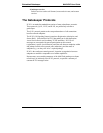
Embedded Gatekeeper MultiVOIP User Guide
482
Zone Management
Note. Zone Management and neighboring gatekeeper functionality are not
included in the current software release. The discussion of this
paragraph pertains primarily to the general theory of gatekeeper
functionality. These functions are included in plans for subsequent
software releases.
The gatekeeper allows or disallows call traffic between neighboring zones,
depending upon established permissions. The zones themselves might be
defined geographically (a company may have facilities in different cities, each
being a separate network zone), by physical network connections (a range of
IP addresses may comprise a zone, as may a subnet on a particular floor of a
building), or by an organizational criterion (e.g., a large company might define
separate network zones for engineering, manufacturing, marketing, and
administration).
Optional Gatekeeper Functions
The MultiVOIP Gatekeeper supports the four main optional gatekeeper
functions: call control signaling, call authorization, bandwidth management,
and call management.
Call Control Signaling
The gatekeeper can, in “routed” mode, act as an intermediary for H.225 call-
control signals between two endpoints participating in a call. In “direct” mode,
this function is turned off and the endpoints exchange H.225 call-control
messages directly.
Call Authorization
The gatekeeper can be programmed to restrict access (admission and
registration) according to criteria set by the user.
Bandwidth Management
This is essentially dynamic bandwidth control (see “Bandwidth Control”
section above).


















